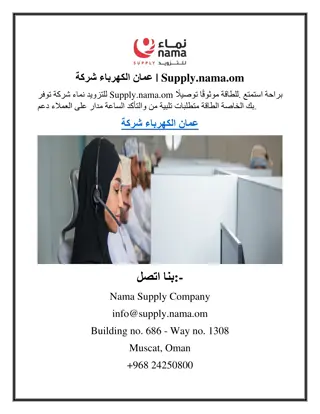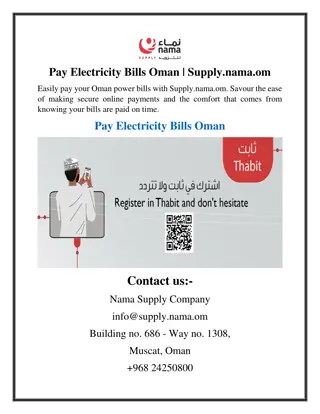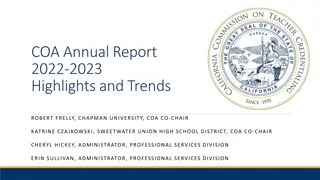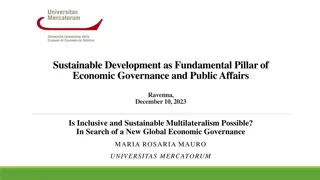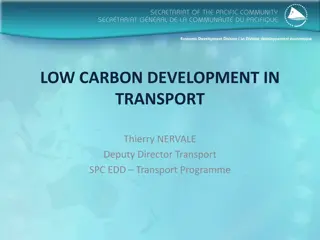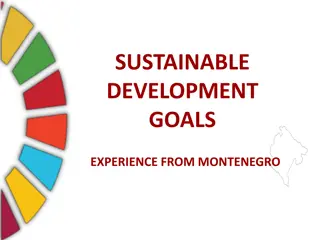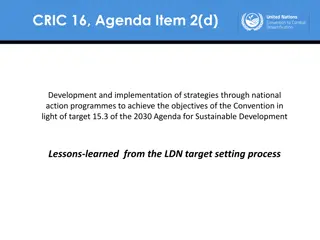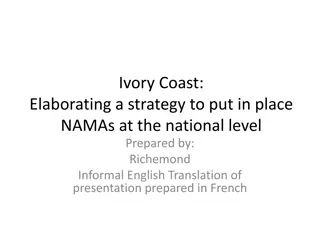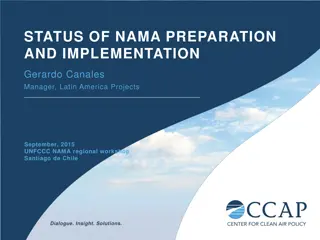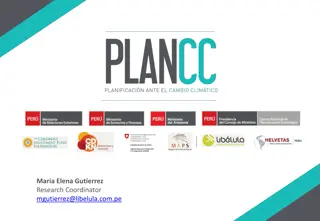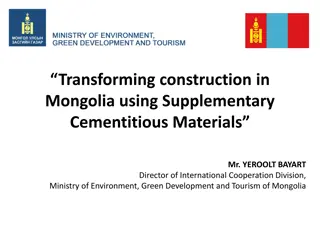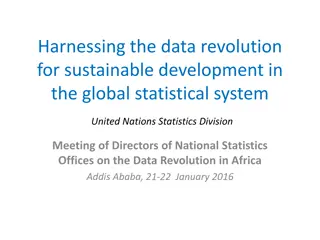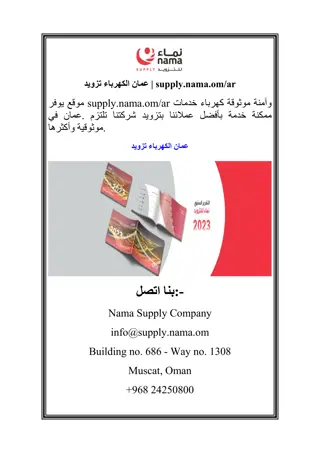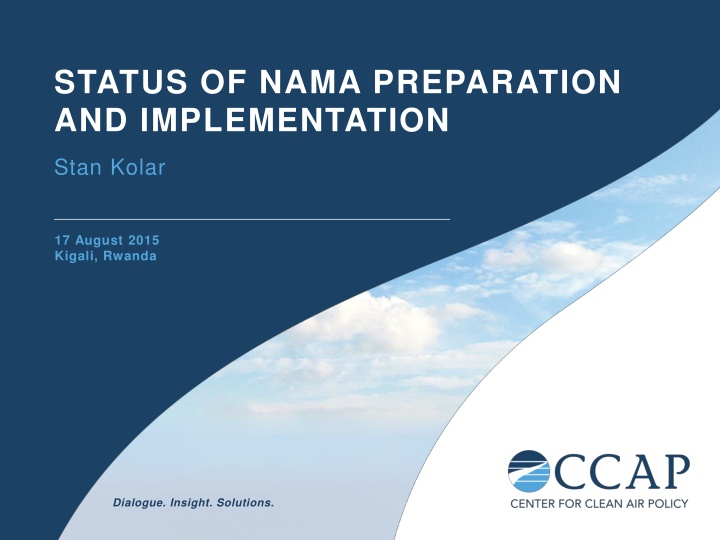
Status of NAMA Preparation and Implementation in Sustainable Development
This content provides insights into the status and implementation of NAMAs (Nationally Appropriate Mitigation Actions) in various sectors such as sustainable urban development, vehicle technology, energy efficiency, renewable energy, and waste management. It discusses the progress, financing opportunities, and active regions in NAMA development. Additionally, it highlights initiatives like the Mitigation Action Implementation Network and specific NAMA projects like the Colombia Transit-Oriented Development.
Download Presentation

Please find below an Image/Link to download the presentation.
The content on the website is provided AS IS for your information and personal use only. It may not be sold, licensed, or shared on other websites without obtaining consent from the author. If you encounter any issues during the download, it is possible that the publisher has removed the file from their server.
You are allowed to download the files provided on this website for personal or commercial use, subject to the condition that they are used lawfully. All files are the property of their respective owners.
The content on the website is provided AS IS for your information and personal use only. It may not be sold, licensed, or shared on other websites without obtaining consent from the author.
E N D
Presentation Transcript
STATUS OF NAMA PREPARATION AND IMPLEMENTATION Stan Kolar 17 August 2015 Kigali, Rwanda Dialogue. Insight. Solutions.
OUTLINE CCAP s MAIN program Status of NAMAs NAMAs in Sustainable Urban Develpopment: Colombia TOD NAMA Vehicle Technology NAMAs Ecuador s Heavy Duty Vehicle NAMA NAMAs in Energy Efficiency: Thailand Refrigerators and A/C NAMAs in Renewable Energy: Kenya Geothermal NAMA NAMAs in Waste: Colombia Waste NAMA Shared Vision on NAMAs NAMA Finance is Flowing Conclusions on NAMAs 1 CCAP
MITIGATION ACTION IMPLEMENTATION NETWORK Goals: Create regional networks of policymakers involved in NAMAs (Asia, Latin America) Build national capacity to identify, design and develop financeable NAMAs Impact the design of the GCF and other NAMA/climate finance programs Facilitate financing for implementation of early NAMAs Components: 1. Regional dialogues of policymakers, experts, potential funders 2. Video conferences with policymakers 3. Harvesting of best practices, case studies, policy analysis, policy papers 4. On-the-ground support for NAMA design, in-country workshops 5. Global dialogues, policy lunches for negotiators 2 CCAP
STATUS OF NAMAS Source: Ecofys/ECN NAMA Status Mid Year update 2015 Source: Ecofys/ECN NAMA Status Mid Year update 2015 The number of NAMAs under development is rising The number of NAMAs under implementation is growing tho small funding has primarily come from the path breaking UK-Germany NAMA Facility, The GCF presents a major new opportunity Latin America has been most active in NAMA development As of 2015, more than 140 NAMAs are developed or in process, with at least 43 seeking implementation support 3 CCAP
SUSTAINABLE URBAN TRANSPORT THE COLOMBIA TRANSIT-ORIENTED DEVELOPMENT NAMA Source: CCAP TOD involves shifting how and where public and private investments are made to increase the environmental, economic and social return on continuing investments in mass transit and social housing Financial and Technical Assistance for cities TOD plans Reduce annual GHG emissions 3.6-5.5 MtCO2e/year by 2040 Status: Preliminary approval by NAMA Facility, finalizing appraisal Developed by Ministries of Environment and Transport, Planning Department, FINDETER, with CCAP support Source: Chamonet.com 4 CCAP
VEHICLE TECHNOLOGY NAMAS ECUADORS HEAVY DUTY VEHICLES NAMA Currently a 70% subsidy for diesel fuel Climate finance to subsidize truck and bus efficiency improvements Expand upon existing retrofit program (Plan Renova) Build upon precedent of cook-stove NAMA that cuts LPG subsidies Policies to limit imports to efficient vehicles and to reduce diesel subsidies Source: howweroll.net 5 CCAP
NAMAS IN ENERGY EFFICIENCY THAILAND REFRIGERATOR AND A/C Emissions account for 20% of country total Four areas of activity Production of green equipment Servicing and use Revisions to policy and Financial Framework Raising awareness Anticipated Mitigation: 19.4 MtCO2e cumulative (2015-19) Status: In Appraisal Source: NAMA Facility 6 CCAP
NAMAS IN RENEWABLE ENERGY KENYA GEOTHERMAL NAMA Geothermal is best technology to keep Kenyan energy sector low-carbon NAMA Supports 820 MW expansion of geothermal capacity in two phases Employs technical assistance, risk guarantees for costly drilling , and capacity building Status: In Development Source: ECN 7 CCAP
NAMAS IN WASTE Source: Mitigation Partnership Source: CCAP Source: Mitigation Partnership Move Solid Waste Management to waste reduction alternatives to reduce landfilling Creation of Equity Fund to support projects Regulatory changes to make alternative technologies economic Emissions reductions: 40% sectoral reduction if fully implemented Status: In development 8 CCAP
SHARED VISION ON TRANSFORMATIONAL NAMAS 1) NAMAs must be host country-driven and incorporate dual goals of greenhouse gas (GHG) mitigation and sustainable development 2) NAMAs should strive to be sector-wide programs that are national in scope, with the potential for regional or municipal elements 3) NAMAs should include both policies and financial mechanisms targeted to address the main barriers to mitigation activities 4) NAMAs should use NAMA funding to catalyze additional private and public sector finance CCAP 9
CLIMATE FINANCE IS FLOWING Green Climate Fund (GCF) GCF operationalization holds great promise for NAMAs $10.3 Billion USD pledged to date Board expected to select first programs/projects in fall 2015 $6 billion of initial resources need to be spent by 2017 to start next replenishment. 200 $10 million projects = $2 billion 25 $40 million programs = $ 2 billion 10 $200 million programs = $ 2 billion NAMA Facility Pre-approved four projects in its second round, announced in Lima: Burkina Faso Biomass Energy Peru Sustainable Urban Transport Tajikistan Forestry NAMA Thailand Refrigeration and AC Denmark and EC have joined to support $100 million 3rd round Third call for proposals open through July 15, 2015 Likely will be a fourth and perhaps more rounds 10 CCAP
GCF AND UK-GERMAN NAMA FACILITY HAVE SIMILAR SELECTION CRITERIA Both selection processes are competitive with similar criteria: GHG Impact Sustainable Development Impact Paradigm Shift (GCF)/ Transformational ambition (NF) - replication, strong regulatory framework Country Ownership Efficiency/ Effectiveness (GCF) leverage (NF) catalyze private sector investment Need (GCF only) GCF also requires 50% of finance flows to adaptation and half of that to LDCs while NF finances only mitigation 11 CCAP
CONCLUSIONS ON NAMAS NAMAs should be bold They should transform existing structures that prevent mitigation (e.g. fossil fuel subsidies, anti-competitive regulations, etc.) and create policies that drive low carbon outcomes NAMAs should be at a program scale By funding programs, rather than specific projects, the funder can achieve greater scale, replication, and overall ambition. Programs should incorporate policy changes, new financial mechanisms, and some bankable projects. Host country institutions should be empowered to select additional domestic projects, based on program criteria that the funder has approved (rather than the funder making investment decisions on each specific project) NAMAs should not only leverage private sector and other funding but also demonstrate paradigm shift . Need to avoid business as usual proposals which show leverage but not transformation. 12 CCAP
NAMAS IN A POST-2015 CONTEXT Investment Strategy GCF Selection INDCs NDC Many INDCs are likely to be quantitative and may not include specifics on sector-specific policies Some developing countries are likely to propose INDCs with elements conditional on international support Conditional INDC elements will likely need to be translated into investment strategies after Paris for consideration by the GCF The NAMA Facility has served as a quasi-laboratory for the GCF to date it could continue to test bold ideas on financing and NAMA design in the future 13 CCAP
THANK YOU For more information, please visit us at www.ccap.org.


